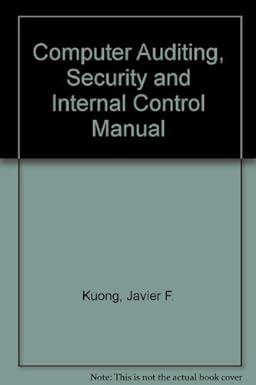Question
In preparing Landers financial statements and income tax return for 2016, you discovered the following information: The lease arrangement with Krump was in effect throughout
In preparing Landers financial statements and income tax return for 2016, you discovered the following information:
The lease arrangement with Krump was in effect throughout 2016;
Landers acquired marketable equity securities for $75,000 during 2016. At December 31, 2016, the fair value of the securities was $90,000. Landers classified the securities as trading (hint: only realized gains and losses are reported on the tax return);
Landers earned $26,000 on Washington State bonds in 2016;
The premium on the key-man life insurance policy increased to $33,000 and was paid in early January;
Landers did not acquire any capital assets in 2016;
The founder of Landers died unexpectedly in December, 2016, and the company received life insurance proceeds of $500,000 in late December.
Landers made additional installment sales in 2016. The gain recognized on the financial statements and the income tax return are shown below:
Gain reported on income statement Gain realized on tax return
2016 $180,000 $44,000
2017 50,000
2018 50,000
2019 36,000
Landers began estimating its warranty expense in 2016. For 2016, the company estimated
its warranty expense to be $66,000. Actual warranty work done on products sold in 2016
was $43,000.
Landers used the direct charge off method of recognizing its bad debts expense in 2015. Customers accounts written off in 2015 amounted to $9,000. For 2016, Landers estimated its bad debts expense to be $15,000. Customers accounts written off during 2016 amounted to $10,000.
Interest earned on U.S. Treasury bills is 2016 amounted to $18,000.
Additional information for 2016:
Income before income tax $1,425,000
Taxable income on line 28 667,000
Tax rate 35%
Estimated income tax payment each quarter 57,000
For each of the following questions, select the best answer and type the letter on the answer sheet that follows the questions in capital letters.
Parts A through S involve the reconciliation of pretax accounting income to taxable income (schedule M-1) for 2016. For each question, indicate the type of difference (temporary
or permanent) and indicate whether the amount of the item is added or subtracted to determine taxable income for 2016.
A. The unrealized gain related to trading securities purchased in 2016:
Type of difference Treatment in the reconciliation
A. Permanent Added
B. Temporary Subtracted
C. Permanent Subtracted
D. Temporary Added
B. The rent earned in 2016:
Type of difference Treatment in the reconciliation
A. Permanent Added
B. Temporary Subtracted
C. Permanent Subtracted
D. Temporary Added
C. The excess of tax depreciation over book depreciation in 2016:
Type of difference Treatment in the reconciliation
A. Permanent Added
B. Temporary Subtracted
C. Permanent Subtracted
D. Temporary Added
D. The gain related to installment sales made in 2015:
Type of difference Treatment in the reconciliation
A. Permanent Added
B. Temporary Subtracted
C. Permanent Subtracted
D. Temporary Added
E. The gain related to installment sales made in 2016:
Type of difference Treatment in the reconciliation
A. Permanent Added
B. Temporary Subtracted
C. Permanent Subtracted
D. Temporary Added
F. The insurance proceeds received on the key-man life insurance in 2016:
Type of difference Treatment in the reconciliation
A. Permanent Added
B. Temporary Subtracted
C. Permanent Subtracted
D. Temporary Added
G. The excess of warranty expense per books over warranty expense per tax:
Type of difference Treatment in the reconciliation
A. Permanent Added
B. Temporary Subtracted
C. Permanent Subtracted
D. Temporary Added
H. The excess of bad debts expense per books over bad debts expense per tax:
Type of difference Treatment in the reconciliation
A. Permanent Added
B. Temporary Subtracted
C. Permanent Subtracted
D. Temporary Added
I. The interest earned on U.S. Treasury bills in 2016 is a
Temporary difference that should be deducted on line 7 in schedule M-1.
Permanent difference that should be added on line 4 in schedule M-1.
Neither A nor B.
J. At December 31, 2016, Landers legal tax obligation is
$233,450.
$228,000.
$5,450.
$5,540.
K. At December 31, 2016, total future taxable amounts were
$212,000.
$269,000.
$293,000.
$278,000.
$284,000.
L. At December 31, 2016, total future deductible amounts were
$56,000.
$28,000.
$38,000.
$61,000.
$69,000.
M. What is the balance in the deferred tax liability at December 31, 2016?
$74,200.
$99,400.
$94,150.
$102,550.
$94,650.
N. What is the balance in the deferred tax asset at December 31, 2016?
$21,350.
$19,600.
$ 9,800.
$13,300.
$24,150.
O. For the year ended December 31, 2016, Landers deferred tax liability
A. increased.
B. decreased.
P. For the year ended December 31, 2016, Landers deferred tax asset
A. increased.
B. decreased.
Q. As a result of the changes in Landers deferred tax asset and liability for 2016, income tax
expense
A. increased.
B. decreased.
R. For the year ended December 31, 2016, Landers tax expense for financial reporting is
$322,600.
$312,400.
$326,200.
$324,200.
S. Landers effective income tax rate for 2016 is
Higher than 35%.
Lower than 35%.
Step by Step Solution
There are 3 Steps involved in it
Step: 1

Get Instant Access to Expert-Tailored Solutions
See step-by-step solutions with expert insights and AI powered tools for academic success
Step: 2

Step: 3

Ace Your Homework with AI
Get the answers you need in no time with our AI-driven, step-by-step assistance
Get Started


